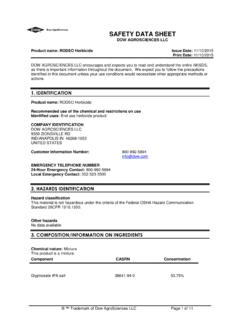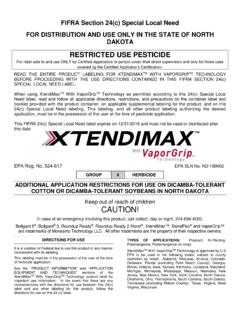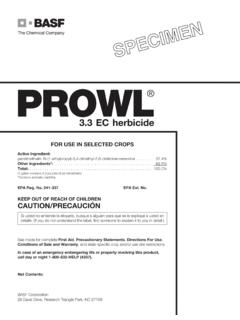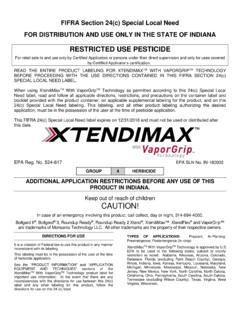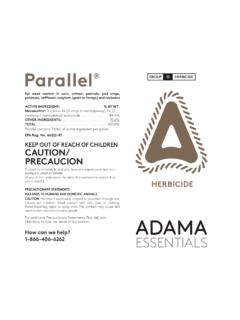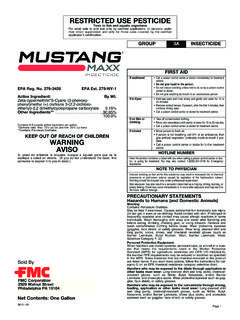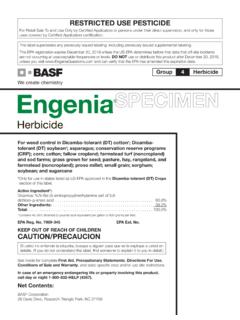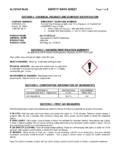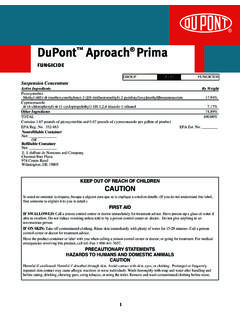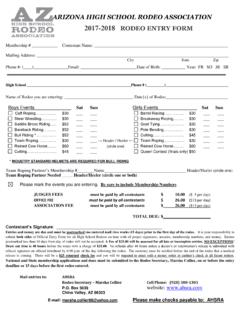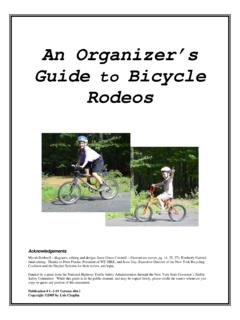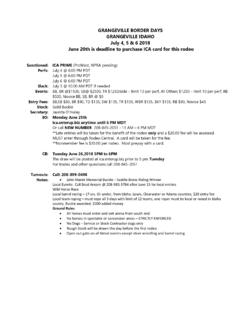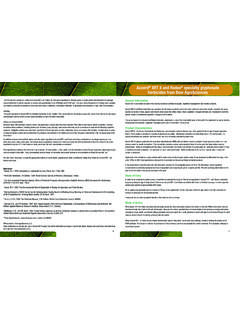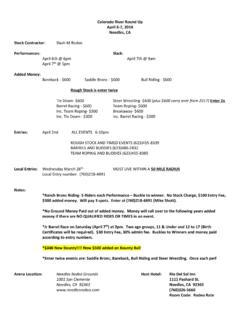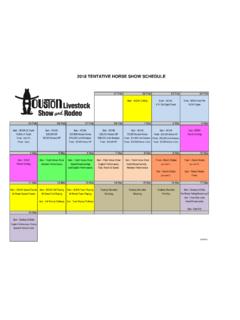Transcription of Specimen Label User Safety Recommendations - …
1 Specimen Label Trademark of The Dow Chemical Company ( Dow ) or an affiliated company of Dow For control of annual and perennial weeds and woody plants in natural and production (plantations), forests for site preparation, mid-rotation release treatments, timber stand improvement activities, noncrop sites including industrial sites, rights-of-way (including roadsides, electric utility and communication transmission lines, pipelines, railroads, airports), irrigation and drainage ditches, canals, reservoirs, natural areas (including wildlife management areas, wildlife openings, wildlife habitats and refuges, parks and recreational areas, campgrounds, trailheads and trails), rangeland, and in and around aquatic sites and wetlands; also for perennial grass release, and grass growth suppression and grazed areas on these sites.
2 Avoid contact of herbicide with foliage, green stems, exposed non-woody roots or fruit of crops, desirable plants and trees, because severe injury or destruction may result. Group9 HERBICIDE Active Ingredient: glyphosate N-(phosphonomethyl)glycine, isopropylamine salt 53 8%Other Ingredients 46 2%Total 100 0% Contains 5 4 lb per gallon glyphosate, isopropylamine salt (4 lb per gallon glyphosate acid)
3 Precautionary Statements Hazards to Humans and Domestic Animals EPA Reg No 62719-324 CAUTION Harmful If Inhaled Avoid breathing spray mist. Remove contaminated clothing and wash before reuse. Wash thoroughly with soap and water after handling. Personal Protective Equipment (PPE)Applicators and other handlers must wear: Long-sleeved shirt and long pants Shoes plus socks. Follow manufacturer's instructions for cleaning/maintaining PPE. If no such instructions for washables, use detergent and hot water. Keep and wash PPE separately from other laundry. Engineering ControlsWhen handlers use closed systems, enclosed cabs, or aircraft in a manner that meets the requirements listed in Worker Protection Standard (WPS) for agricultural pesticides [40 CFR (d)(4-6)], the handler PPE requirements may be reduced or modified as specified in the WPS.
4 User Safety RecommendationsUsers should: Wash hands before eating, drinking, chewing gum, using tobacco, or using the toilet. Remove clothing immediately if pesticide gets inside. Then wash thoroughly and put on clean clothing. First AidIf inhaled: Move person to fresh air If person is not breathing, call 911 or an ambulance, then give artificial respiration, preferably mouth-to-mouth if possible. Call a poison control center or doctor for further treatment advice Have the product container or Label with you when calling a poison control center or doctor, or going for treatment. You may also contact 1-800-992-5994 for emergency medical treatment information Environmental HazardsDo not contaminate water when cleaning equipment or disposing of equipment washwaters.
5 Treatment of aquatic weeds can result in oxygen depletion or loss due to decomposition of dead plants. This oxygen loss can cause fish suffocation. In case of leak or spill, soak up and remove to a landfill. Physical or Chemical HazardsSpray solutions of this product should be mixed, stored and applied using only stainless steel, aluminum, fiberglass, plastic or plastic-lined steel containers Do not mix, store or apply this product or spray solutions of this product in galvanized steel or unlined steel (except stainless steel) containers or spray tanks. This product or spray solutions of this product react with such containers and tanks to produce hydrogen gas, which may form a highly combustible gas mixture.
6 This gas mixture could flash or explode, causing serious personal injury, if ignited by open flame, spark, welder's torch, lighted cigarette or other ignition source. Directions for UseIt is a violation of Federal law to use this product in a manner inconsistent with its labeling Read all Directions for Use carefully before applying. This is an end-use product. Dow AgroSciences does not intend and has not registered it for reformulation. Do not apply this product in a way that will contact workers or other persons, either directly or through drift. Only protected handlers may be in the area during application.
7 For any requirements specific to your state or tribe, consult the agency responsible for pesticide regulation. Agricultural Use RequirementsUse this product only in accordance with its labeling and with the Worker Protection Standard, 40 CFR Part 170. This Standard contains requirements for the protection of agricultural workers on farms, forests, nurseries, and greenhouses, and handlers of agricultural pesticides. It contains requirements for training, decontamination, notification, and emergency assistance. It also contains specific instructions and exceptions pertaining to the statements on this Label about personal protective equipment (PPE), and restricted entry interval.
8 The requirements in this box only apply to uses of this product that are covered by the Worker Protection Standard. Do not enter or allow worker entry into treated areas during the restricted entry interval (REI) of 4 hours. PPE required for early entry to treated areas that is permitted under the Worker Protection Standard and that involves contact with anything that has been treated, such as plants, soil, or water, is: Coveralls Chemical-resistant gloves made of any waterproof material Shoes plus socks Non-Agricultural Use RequirementsThe requirements in this box apply to uses of this product that are NOT within the scope of the Worker Protection Standard for agricultural pesticides (40 CFR Part 170).
9 The WPS applies when this product is used to produce agricultural plants on farms, forests, nurseries or greenhouses. Keep people and pets off treated areas until spray solution has dried. 2 Specimen Label Revised 01-05-17 Storage and DisposalDo not contaminate water, food, feed or seed by storage or disposal Pesticide Storage: Store above 10 F (-12 C) to keep product from crystallizing. Crystals will settle to the bottom If allowed to crystallize, place in a warm room 68 F (20 C) for several days to redissolve and roll or shake container or recirculate in mini-bulk containers to mix well before Disposal: Wastes resulting from use of this product that cannot be used or chemically reprocessed should be disposed of in a landfill approved for pesticide disposal or in accordance with applicable Federal, state or local procedures.
10 Nonrefillable containers 5 gallons or less:Container Handling: Nonrefillable container. Do not reuse or refill this container Triple rinse or pressure rinse container (or equivalent) promptly after emptying Triple rinse as follows: Empty the remaining contents into application equipment or a mix tank and drain for 10 seconds after the flow begins to drip. Fill the container 1/4 full with water and recap. Shake for 10 seconds. Pour rinsate into application equipment or a mix tank or store rinsate for later use or disposal. Drain for 10 seconds after the flow begins to drip. Repeat this procedure two more times Pressure rinse as follows: Empty the remaining contents into application equipment or a mix tank and continue to drain for 10 seconds after the flow begins to drip.
